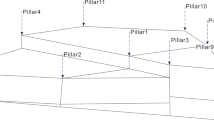Abstract
In many domains, numerical models are initialized with inputs defined on irregular grids. In petroleum reservoir engineering, they consist of a great variety of grid cells of different size and shape to enable fine-scale modeling in the vicinity of the wells and coarse modeling in less important regions. Geostatistical simulation algorithms, which are used to populate the cells of unstructured grids, often have to address the problem of transition from the small-scale statistical data stemming from laboratory cores analysis and seismic processing to the multiple larger scale geological supports. The reasonable generalization of the above-mentioned problem is integrating the point-support data to simulations on irregular supports. Classical geostatistical simulation methods for generating realizations of a stationary Gaussian random function cannot be applied to unstructured grids directly, because of the uneven supports. This article provides a critical review of existing geostatistical simulation methodologies for unstructured grids, including fine-scale simulations with upscaling and direct sequential simulation algorithms, and presents two different generalizations of the discrete Gaussian model for this purpose, thereby discussing the theoretical assumptions and the accuracy when implementing these models.








Similar content being viewed by others
References
Brown G, Ferreira J, Lantuéjoul C (2008) Conditional simulation of a Cox process using multiple sample supports. In: Ortiz JM, Emery X (eds) 8th international geostatistics congress. Gecamin, Santiago, pp 459–468
Chilès J-P (2014) Validity range of the discrete Gaussian change-of-support model and its variant. J South Afr Inst Min Metall 114:231–235
Chilès J-P, Delfiner P (2012) Geostatistics: modeling spatial uncertainty, 2nd edn. Wiley, Hoboken
Cressie N, Wikle CK (2011) Statistics for spatio-temporal data. Wiley, Hoboken
de Fouquet C (1994) Reminders on the conditioning kriging. In: Armstrong M, Dowd PA (eds) Geostatistical simulations. Springer, Netherlands, pp 131–145
Emery X (2007) On some consistency conditions for geostatistical change-of-support models. Math Geol 39:205–223
Emery X (2009) Change-of-support models and computer programs for direct block-support simulation. Comput Geosci 35:2047–2056
Farmer C (2002) Upscaling: a review. Int J Numer Methods Fluids 40:63–78
Goovaerts P (1997) Geostatistics for natural resources evaluation. Oxford University Press, Oxford
Journel AG (1993) Modeling uncertainty: some conceptual thoughts. In: Dimitrakopoulos R (ed) Geostatistics for the next century. Kluwer Academic Pub, Dordrecht, pp 30–43
Lantuéjoul C (2002) Geostatistical simulation: models and algorithms. Springer, Berlin
Manchuk JG (2010) Geostatistical modeling of unstructured grids for flow simulation. Unpublished dissertation, doctoral, University of Alberta
Manchuk JG, Leuangthong O, Deutsch CV (2005) Direct geostatistical simulation on unstructured grids. In: Leuangthong O, Deutsch CV (eds) Geostatistics Banff 2004. Springer, Netherlands, pp 85–94
Matheron G (1976) A simple substitute for conditional expectation: the disjunctive kriging. In: Guarascio M, David M, Huijbregts C (eds) Advanced geostatistics in mining industry, pp 221–236
Matheron G (1985) Change of support for diffusion-type random functions. J Int Assoc Math Geol 17:137–165
Matheron G (1989) Estimating and choosing. Springer, Berlin
Oz B, Deutsch CV, Tran T, Xie Y (2003) DSSIM-HR: a FORTRAN 90 program for direct sequential simulation with histogram reproduction. Comput Geosci 29(1):39–51
Rivoirard J (1994) Introduction to disjunctive kriging and non-linear geostatistics (spatial information systems). Oxford University Press, Oxford
Robertson RK, Mueller UA, Bloom LM (2006) Direct sequential simulation with histogram reproduction: a comparison of algorithms. Comput Geosci 32:382–395
Shiryaev A (1996) Probability, 2nd edn. Springer, New York
Soares A (2001) Direct sequential simulation and cosimulation. Math Geol 33:911–926
Author information
Authors and Affiliations
Corresponding author
Appendix: Covariance Relations
Appendix: Covariance Relations
This section demonstrates that simulations produced with generalized DGM 2 are biased in terms of covariance relative to the theoretically expected result. The theoretical expression of the covariance between \(Z(v_p )\) and \(Z(v_q )\) for two blocks \(v_p \) and \(v_q \)can be expressed as follows
For DGM 2, the block-to-block covariance is equal to
which does not coincide with the expected theoretical result. The difference \(\Delta \) between the theoretical and implied by DGM 2 covariance values is
which finalizes the proof.
Rights and permissions
About this article
Cite this article
Zaytsev, V., Biver, P., Wackernagel, H. et al. Change-of-Support Models on Irregular Grids for Geostatistical Simulation. Math Geosci 48, 353–369 (2016). https://doi.org/10.1007/s11004-015-9614-x
Received:
Accepted:
Published:
Issue Date:
DOI: https://doi.org/10.1007/s11004-015-9614-x




